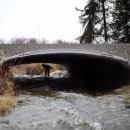States
WyomingThis project will widen and lower the elevation of a channel-wide sill on the Green River in Wyoming. The sill was constructed to support water diversion to the Killdeer Wetlands and now creates safety concerns for those recreating on the river and impedes fish passage fish passage
Fish passage is the ability of fish or other aquatic species to move freely throughout their life to find food, reproduce, and complete their natural migration cycles. Millions of barriers to fish passage across the country are fragmenting habitat and leading to species declines. The U.S. Fish and Wildlife Service's National Fish Passage Program is working to reconnect watersheds to benefit both wildlife and people.
Learn more about fish passage . This project will improve fish passage and safety at the site while continuing to support the wetland area. Species that benefit from this work include native mountain whitefish, flannelmouth sucker, Kokanee and brown trout. Improving the current structure will providing habitat for migratory, wetland, raptor, and passerine birds, such as the trumpeter swan. Impacts from climate change climate change
Climate change includes both global warming driven by human-induced emissions of greenhouse gases and the resulting large-scale shifts in weather patterns. Though there have been previous periods of climatic change, since the mid-20th century humans have had an unprecedented impact on Earth's climate system and caused change on a global scale.
Learn more about climate change are expected to result in reduced annual rain and vital snowpack that feeds the Green River, while increasing extreme storm events. This project will allow necessary waterflow for fish passage in dryer future conditions while mediating against flood hazards. Completion of the project will increase outdoor recreation opportunities to support the community’s economic development.
Project Quick Facts:
| Project Status | In Development |
| Location | WY, Sweetwater county |
| NFPP Project Funding | $250,000 |
| Restoration Techniques | Channel Reconstruction |
| Accomplishments | 60 Stream Miles Reopened |
| Partner Project Lead | City of Green River |
The National Fish Passage Program combines technical expertise with a track record of success.
Implemented primarily through the Service's Fish and Wildlife Conservation Offices, the National Fish Passage Program provides financial and technical assistance to partners across the country. Since 1999, the program has worked with over 2,000 local communities, Tribes, and private landowners to remove or bypass over 3,400 barriers to fish passage and reopen access to over 61,000 miles of upstream habitat for fish and other animals. Staff have expertise in fish migration and biology as well as financial, engineering, and planning assistance to communities, Tribes, and landowners to help them remove barriers and restore rivers for the benefit both fish and people.
Fish passage project proposals can be initiated by any individual, organization, government, or agency. However, proposals must be submitted and completed in cooperation with a Fish and Wildlife Conservation Office. (Please note that fish passage projects being used for federal or state compensatory mitigation or required by existing federal or state regulatory programs are not eligible for funding through the National Fish Passage Program.)
CONTACT A FISH PASSAGE COORDINATOR IN YOUR AREA TO GET STARTED.

